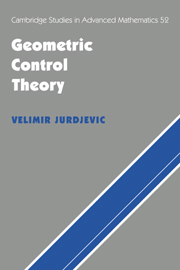Book contents
- Frontmatter
- Contents
- Introduction
- Acknowledgments
- Part one Reachable sets and controllability
- 1 Basic formalism and typical problems
- 2 Orbits of families of vector fields
- 3 Reachable sets of Lie-determined systems
- 4 Control affine systems
- 5 Linear and polynomial control systems
- 6 Systems on Lie groups and homogeneous spaces
- Part two Optimal control theory
- References
- Index
6 - Systems on Lie groups and homogeneous spaces
Published online by Cambridge University Press: 07 October 2009
- Frontmatter
- Contents
- Introduction
- Acknowledgments
- Part one Reachable sets and controllability
- 1 Basic formalism and typical problems
- 2 Orbits of families of vector fields
- 3 Reachable sets of Lie-determined systems
- 4 Control affine systems
- 5 Linear and polynomial control systems
- 6 Systems on Lie groups and homogeneous spaces
- Part two Optimal control theory
- References
- Index
Summary
Continuing with the general theme begun in Chapter 5 of amalgamating the basic theory with additional mathematical structures, we shall now consider differential systems possessing group symmetries. Having in mind particular applications in geometry, mechanics, and control of mechanical systems, this chapter focuses on differential systems on Lie groups having either left or right invariance properties. We shall presently show that the basic geometric control theory described in earlier chapters adapts well to systems on Lie groups, and when enriched with additional geometric structure, it provides a substantial theoretical foundation from which various mathematical topics can be effectively pursued. The reader may find it useful to consider, first, several specific situations that have motivated our interest in much of the material in this chapter.
Motions of a rigid body The motions of a rigid body around a fixed point in a Euclidean space E3 can be viewed as paths in the group of rotations SO3(R). The correspondence between the motions and the paths is achieved through an orthonormal frame attached to the body, called a moving frame, and an orthonormal frame stationary in the ambient space. The stationary frame is called fixed or absolute. At each instant of time, the position of the body is described by a rotation defined by the displacement of the moving frame relative to the fixed frame.
Associated with each path in the rotation group is its angular velocity. We shall be interested in the motions of a rigid body whose angular velocities are constrained to belong to a fixed subset of ℝ3. Such situations typically occur in the presence of non-holonomic constraints.
- Type
- Chapter
- Information
- Geometric Control Theory , pp. 150 - 194Publisher: Cambridge University PressPrint publication year: 1996

